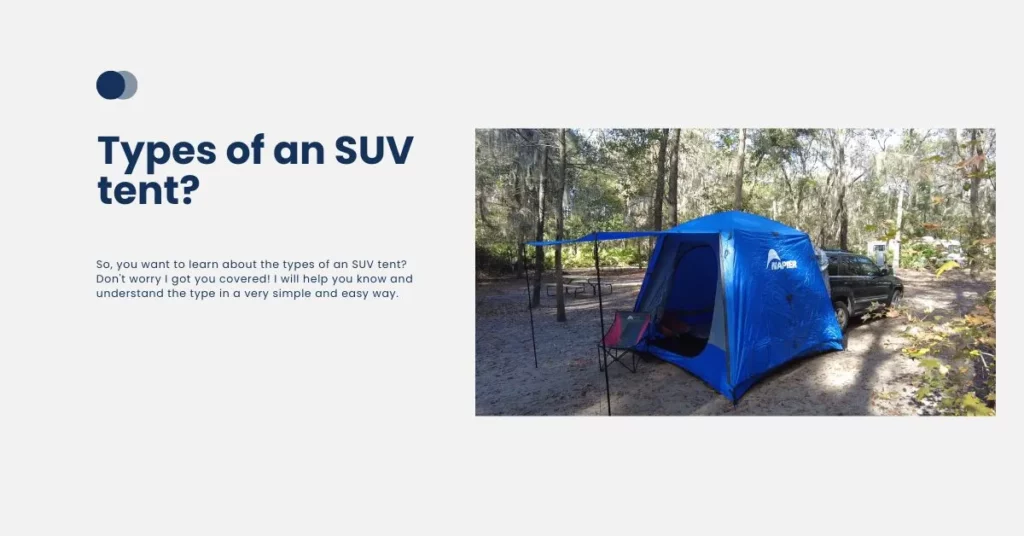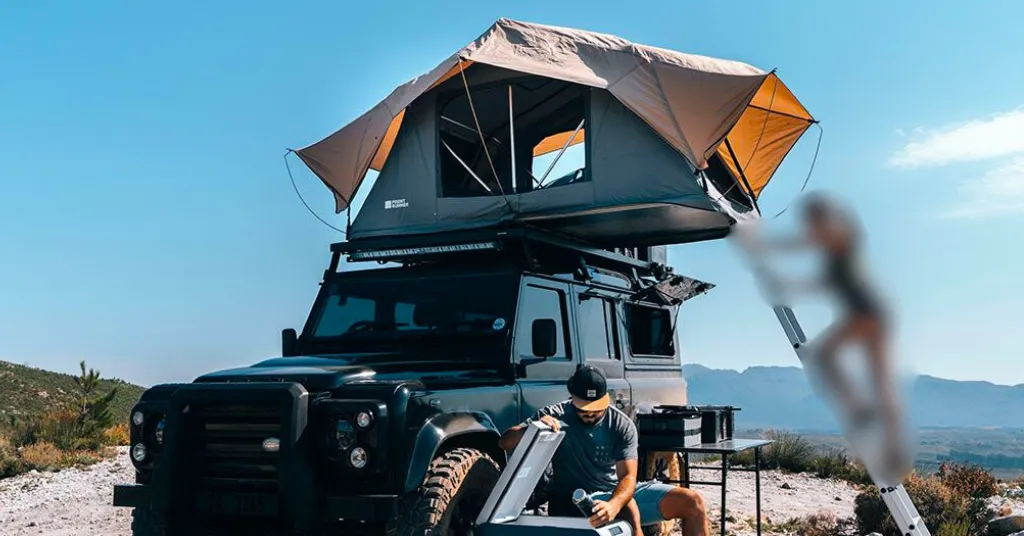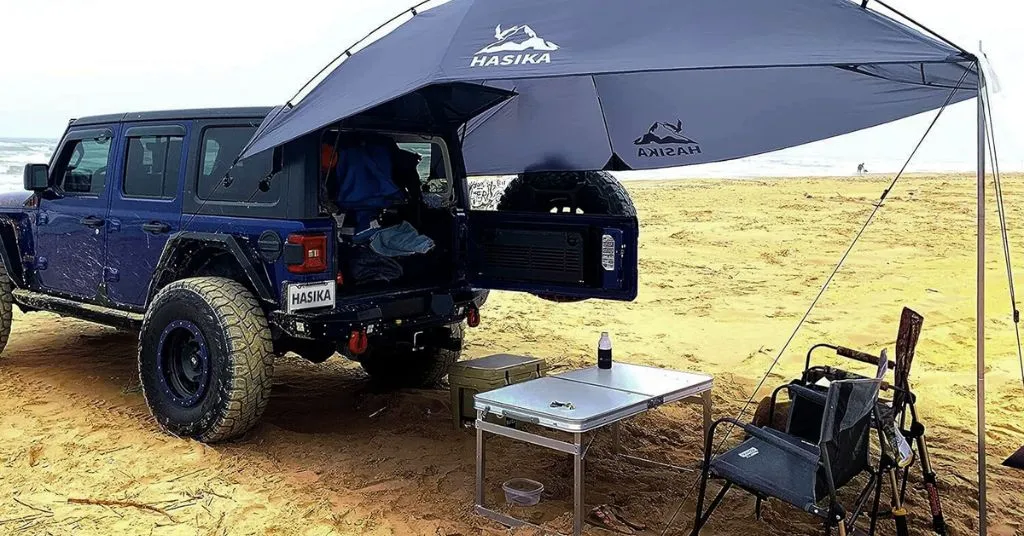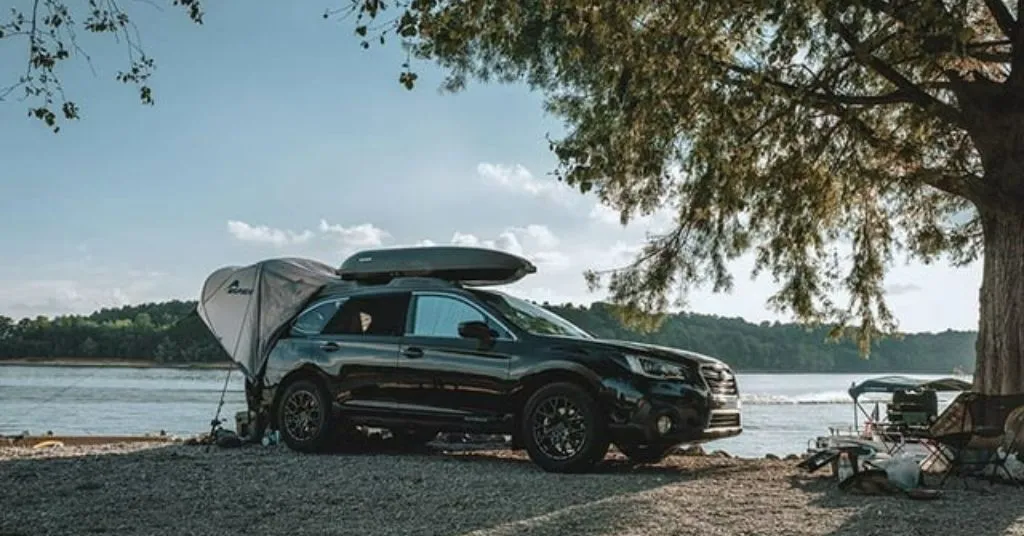
So, you want to learn about the types of an SUV tent? Don’t worry I got you covered! I will help you know and understand the type in a very simple and easy way.
So, what are you waiting for? Your friends are ready for an amazing camping trip, so let’s learn and apply that knowledge in our next tent camping trip!
What is an SUV Tent?

Before delving into the different types of SUV tents, let’s understand what an SUV tent is. An SUV tent is a versatile and convenient camping solution that attaches to your vehicle, expanding your living space and providing shelter during outdoor adventures.
Whether you own an SUV, minivan, or a similar vehicle, there are various types of SUV tents designed to suit different preferences and needs.
Types of an SUV Tent
There are four types of an SUV tent, every tent has its features and advantages. Let’s discuss them all:
1. Hatchback SUV Tents

Hatchback tents are an extension of your vehicle’s trunk space, attaching to the rear ends of SUVs, minivans, and similar vehicles. Here’s what you need to know:
Advantages:
- Convenience: Hatchback tents provide quick access to your vehicle.
- Extra Space: They offer additional covered space for sleeping, lounging, and storing gear.
- Weather Protection: Keep rain and wind at bay while enjoying the outdoors.
Examples:
- Napier Sportz Dome-ToGo Tent: Spacious with large doors and mesh windows.
- Rightline Gear SUV Tent: Budget-friendly and easy to set up.
2. Roof-Top SUV Tents

Roof-top tents are mounted on your SUV’s roof rack, providing an elevated sleeping area popular among off-road enthusiasts. Here’s why they’re worth considering:
Advantages:
- Off-the-Ground Sleeping: Stay away from rocks, insects, and uneven terrain.
- 360-Degree Views: Enjoy panoramic vistas from your elevated perch.
- Quick Setup: No need to find a flat surface; unfold and extend.
Examples:
- Front Runner Rooftop Tent: Convenient for truck campers who need the bed for storage.
- Smittybilt Overlander Tent: All-season rooftop tent for rugged adventures.
3. SUV Awning Tents

While not a separate category, SUV awning tents deserve mention. These attach to your SUV’s existing awning or roof rack, offering versatility. Here’s why they’re worth considering:
Advantages:
- Additional Space: Create a shaded area next to your vehicle.
- Versatility: Use it as a dining area, changing room, or shelter from the elements.
- Easy Setup: Roll out the awning and attach the tent.
Examples:
- HASIKA Versatility Teardrop Awning: Perfect for family picnics and beach outings.
4. Tailgate Tents

Tailgate tents are designed for sports fans, campers, and outdoor gatherings. Set up right at the back of your SUV during tailgating events. Here’s what you need to know:
Advantages:
- Party Central: Hang out with friends and fellow fans.
- Easy Access: Grab snacks and drinks from your car without leaving the party.
- Comfortable Lounging: Enjoy the game while sheltered from the elements.
Examples:
- Napier Sportz Cove SUV Tailgate Tent: Ideal for sleeping in your car during events.
How to Set up An SUV Tent

Setting up an SUV tent is a straightforward process that enhances your camping experience. Follow these steps:
- Unpack and Lay Flat:
- Remove the tent from its bag and lay it flat on the ground.
- Orient the vehicle sleeve toward the cargo area and position the screen room on the driver’s side.
- Assemble the Poles:
- The tent has six poles: five fiberglass poles and two awning poles.
- Unfold each tent section and assemble the poles.
- Slide the fiberglass poles diagonally from corner to corner.
- Insert each pole through the sleeve in the tent roof, securing one end into the hub center.
- Attach to the Vehicle:
- Fasten the tent to your SUV’s rear using restraining straps.
- Use an elastic band around the back of the car for added stability.
- Set Up the Rainfly:
- Attach the rainfly to protect against precipitation.
- Ensure proper coverage and secure it using stakes and guylines.
- Ventilation and Comfort:
- Open windows and vents for airflow.
- Arrange your sleeping area, keeping comfort in mind.
Final Thoughts
Choosing the right type of SUV tent depends on your camping style, preferences, and the type of outdoor activities you enjoy.
Whether it’s a hatchback tent for convenience, a roof-top tent for off-road adventures, an SUV awning tent for versatility, or a tailgate tent for social gatherings, there’s a suitable option to enhance your camping experience.
Set up your SUV tent with ease, and enjoy the great outdoors with added comfort and convenience.
Frequently Asked Questions
What is the main advantage of using a hatchback tent for camping?
Hatchback tents provide quick access to your vehicle, offering convenience during camping trips. They also offer additional covered space for sleeping, lounging, and storing gear.
How do roof-top tents differ from other types of SUV tents?
Roof-top tents are mounted on the SUV’s roof rack, providing an elevated sleeping area. This design keeps campers off the ground, away from rocks and insects. They are particularly popular among off-road enthusiasts due to their quick setup and panoramic views.
Are SUV awning tents a separate category, and what makes them versatile?
SUV awning tents are not a separate category but are worth mentioning. They attach to your SUV’s existing awning or roof rack, creating additional shaded space next to the vehicle. This versatility allows for various uses, such as a dining area, changing room, or shelter from the elements.
What makes tailgate tents suitable for events and social gatherings?
Tailgate tents are designed for sports fans, campers, and outdoor gatherings. They are set up at the back of your SUV during tailgating events, providing a central hub for socializing. Easy access to snacks and drinks from the vehicle makes them ideal for creating a comfortable and social atmosphere.
Can you briefly overview the steps to set up an SUV tent?
Setting up an SUV tent involves unpacking and laying it flat, assembling the poles, attaching it to the vehicle, setting up the rainfly for weather protection, and ensuring proper ventilation. Specifics may vary by tent model, but these general steps enhance the camping experience with added comfort and convenience.
